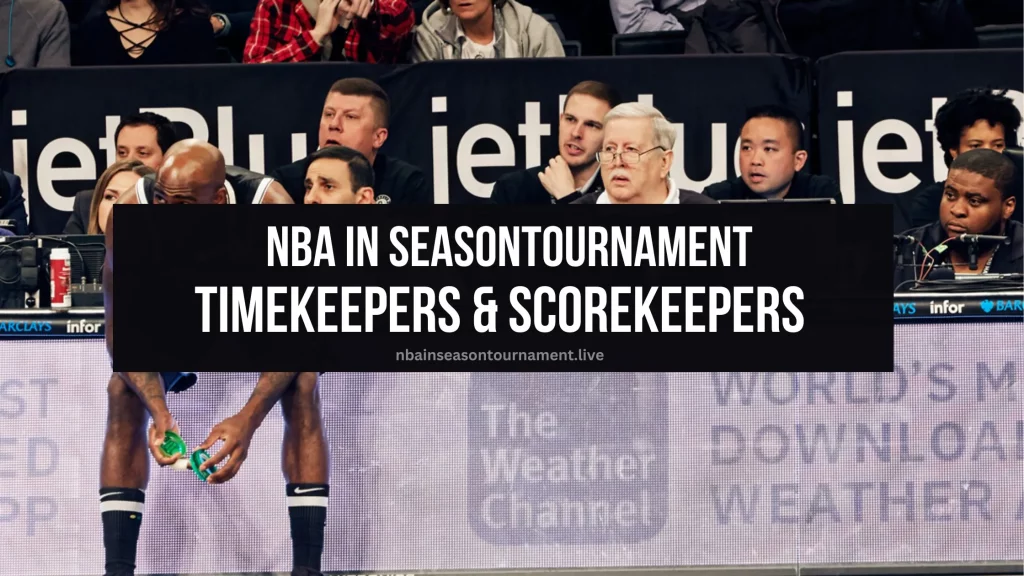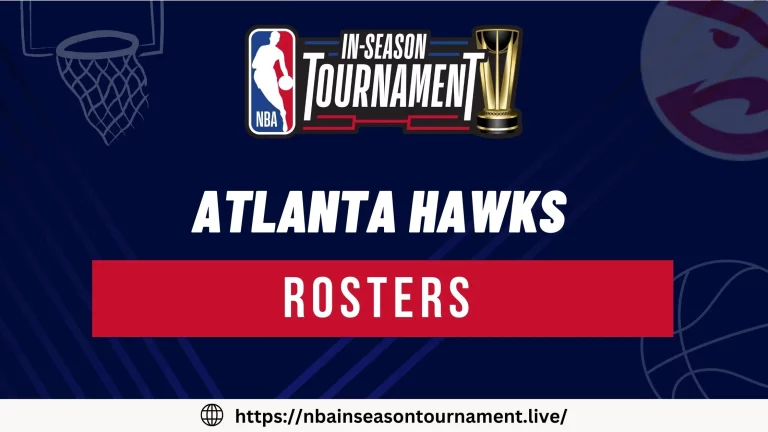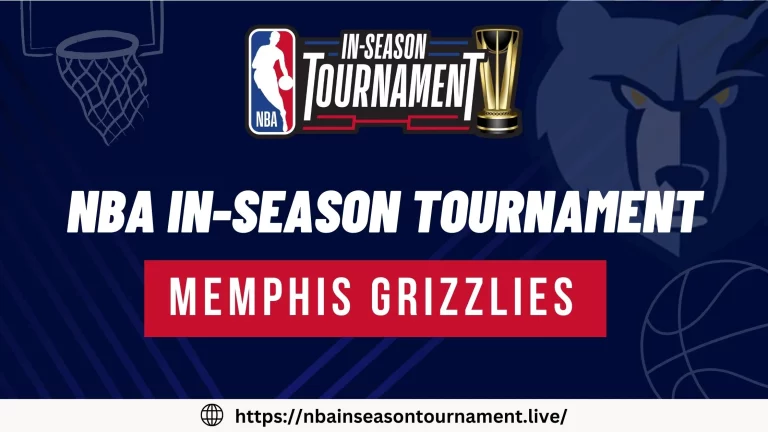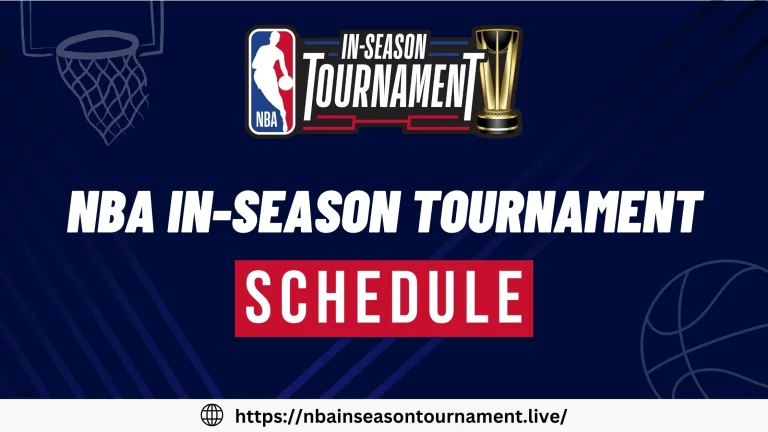NBA In-Season Tournament Timekeeper & Scorekeeper Lists
NBA In-Season Tournament Timekeeper & Scorekeeper Lists: In the world of professional basketball, precision and accuracy are paramount, not just on the court but also behind the scenes. To ensure the smooth operation of a game, a team of dedicated interns takes on the crucial roles of scorekeepers and timekeepers. These individuals play a vital role in recording every point, foul, and moment of play, ensuring that the game runs seamlessly.
This system of scorekeeping and timekeeping is not exclusive to the NBA but extends to various basketball leagues, including in-season tournaments. In this article, we will share NBA in season tournament timekeeper & scorekeeper list.

NBA In-Season Tournament Timekeeper & Scorekeeper Lists
The NBA, known for its thrilling regular season and epic playoffs, is all set to add a new dimension to the basketball universe with the introduction of the NBA In-Season Tournament during the 2023-24 season. This article dives deep into the tournament’s details, including its format, schedule, and the crucial roles of timekeepers and scorekeepers. We’ll also explore the teams, groups, and the exciting prospects this tournament holds.
Timekeepers and Scorekeepers List
Every great NBA game relies on precise timekeeping and scorekeeping. The responsibility of these roles is often entrusted to interns, who play a pivotal role in ensuring the game runs smoothly.
Also Read: NBA In-Season Tournament Prize Pool
Scorekeepers
Role: Scorekeepers are the record-keepers of the game. Their primary duties include recording scores, fouls, and timeouts for both teams. Here are their responsibilities:
Before the Game
- Team and Player Details: Enter the team names, coaches’ names, and all player names and numbers for both teams, preferably in numeric order for easy reference.
- Referee Check: The referee should verify the scorebook before the game starts.
During the Game
- Individual Fouls: Keep track of individual fouls. When a foul is called, record the player’s number who committed the foul and notify the referee when a player has fouled out.
- Team Fouls: Keep count of team fouls. Upon the 7th team foul, the fouled player gets free throws. Inform the referee when a team enters the bonus.
- Team Score: Update the team’s score by crossing out numbers at the top of the scorebook.
- Individual Player Scores: Track individual player points, including 2-point and 3-point shots. Indicate attempted free throws with an empty circle and fill it or mark it with an ‘x’ if the free throw is made.
- Timeouts: Record timeouts for each team at the bottom of their respective pages.
Also Read: NBA In-Season Tournament Brackets 2023
Timekeepers
Role: Timekeepers are responsible for managing the game clock, ensuring accurate timing during play, and following specific protocols for timeouts and substitutions.
During the Game
- Game Clock: Start and stop the game clock as directed by the referee. In a running clock system, the clock only stops for official timeouts and during the last minute of the second half.
- Team’s Scores: Keep track of the team’s scores after made baskets.
- Substitutions: Sound the buzzer at a stoppage of play when a substitute reports to the table.
- Timeouts: During timeouts, manage the timing. Sound the buzzer after 40 seconds and again after 55 seconds.
- Bonus: Activate the bonus light on the clock if the game reaches the bonus stage.
At the Breaks
- Quarter Breaks: Reset the game clock and quarter time to the appropriate values and follow timeout buzzer rules.
- Halftime Break: Reset the game clock, set the quarter time to 1:00, and follow halftime timing protocols.
Also Read: NBA In-Season Tournament Trophy & Prize Money ANNOUNCED
NBA In-Season Tournament Timekeeper and Scorekeeper Details
As we’ve delved into the tournament’s format, teams, and groups, let’s now focus on the unsung heroes who ensure the games run smoothly: the timekeepers and scorekeepers. These roles, often filled by interns, are integral to the NBA’s success.
Responsibilities of Scorekeepers
Pre-Game Duties
Before the game commences, scorekeepers have crucial tasks to complete:
- Team and Player Details: Record the team names, coaches’ names, and all player names and numbers for both teams, arranging them numerically for easy reference.
- Referee Verification: Collaborate with the referee to ensure the scorebook is accurate and complete.
In-Game Duties
During the game, scorekeepers take on several responsibilities:
- Individual Fouls: Carefully note down individual fouls as the referee signals them. Ensure you record the player’s number who committed the foul and promptly inform the referee when a player fouls out.
- Team Fouls: Keep track of team fouls. On the 7th team foul, inform the referee, as the fouled player will have the opportunity to shoot free throws (commonly referred to as being “in the bonus”).
- Team Score: Keep an accurate record of the team’s score by crossing out numbers at the top of the scorebook.
- Individual Player Scores: Track individual player points, distinguishing between 2-point and 3-point shots. Mark attempted free throws with an empty circle, filling or marking it with an ‘x’ if the free throw is successful.
- Timeouts: Record timeouts for each team in the designated boxes at the bottom of their respective scorebook pages.
Also Read: NBA In-Season Tournament Groups
Responsibilities of Timekeepers
Timekeepers play a crucial role in managing the game clock and ensuring the game’s timing runs smoothly:
During the Game
- Game Clock: Start and stop the game clock according to the referee’s instructions. In a running clock system, the clock only stops for official timeouts and during the last minute of the second half.
- Team’s Scores: Keep an up-to-date record of the team’s scores after every made basket.
- Substitutions: Sound the buzzer when a substitute reports to the table during a stoppage of play.
- Timeouts: Manage the timing during timeouts, sounding the buzzer after 40 seconds and again after 55 seconds.
- Bonus: Activate the bonus light on the clock if the game reaches the bonus stage.
At the Breaks
- Quarter Breaks: Reset the game clock and quarter time to the appropriate values, adhering to the buzzer rules for timeouts.
- Halftime Break: Reset the game clock to 1:00 and initiate it. Set the quarter time to reflect the second quarter. Follow the halftime timing protocol.
Also Read: NBA In-Season Tournament Commentators
Key Moments in an NBA Game
To help you understand the critical moments that timekeepers and scorekeepers are responsible for, let’s explore some key elements of an NBA game:
Scoring
Scoring in basketball is straightforward. Teams earn points by making baskets, with the value of the basket determined by the player’s proximity to the three-point line. Here’s how scoring works:
- 2-Point Basket: When a player scores from inside the three-point line, the team earns 2 points.
- 3-Point Basket: If a player successfully makes a basket from beyond the three-point line, the team receives 3 points.
- Free Throws: Players get the opportunity to score free throws if they are fouled during a shot attempt. Each successful free throw is worth 1 point.
Fouls and Team Fouls
Fouls are a fundamental part of basketball, and they play a significant role in the game’s strategy. Scorekeepers and timekeepers are responsible for tracking fouls and team fouls:
- Individual Fouls: When a player commits a foul, the referee signals to the scorekeeper, who records the player’s number. A player who accumulates too many fouls (usually five in the NBA) fouls out of the game.
- Team Fouls: Scorekeepers must keep track of team fouls. Once a team reaches the 7th team foul in a half, the opposing player who was fouled gets to shoot free throws. This is known as being “in the bonus.”
Time Management
Timekeepers play a vital role in managing the game clock:
- Game Clock: The game clock measures the total time played in each quarter. Timekeepers start the clock upon the referee’s indication and stop it when the referee blows the whistle (except during official timeouts and the final minute of the second half in a running clock system).
Timeouts
Teams have the option to call timeouts to regroup, strategize, or make substitutions. Timekeepers are responsible for managing the timing during timeouts, sounding the buzzer at specific intervals.
Tournament Format: A Blend of Tradition and Innovation
This tournament’s format is a fresh take on the traditional NBA schedule. It incorporates elements from European soccer tournaments and the WNBA Commissioner’s Cup, adding a unique twist to the NBA calendar. Let’s break down the key aspects of the tournament:
Group Play
The tournament kicks off with the Group Play stage, which takes place on Tuesdays and Fridays in November during the 2023-24 regular season. On these “Tournament Nights,” only NBA games are scheduled, creating an exclusive basketball experience.
National Television Broadcasts
The excitement goes beyond the arenas, as ESPN and TNT have joined forces to broadcast 14 Group Play games. The action begins with a doubleheader on ESPN as the New York Knicks clash with the Milwaukee Bucks, followed by the San Antonio Spurs facing off against the Oklahoma City Thunder on TNT. Meanwhile, the Denver Nuggets take on the LA Clippers in Denver.
Rivalry Rematches
Group Play promises riveting matchups, including three rematches from the 2023 NBA Playoffs broadcasted nationally. The Miami Heat visit the Knicks, the Bucks host the Bucks (an intriguing intra-city duel), and the Golden State Warriors take on the Sacramento Kings. These games are sure to stir nostalgia and anticipation among fans.
NBA TV Coverage
NBA TV ensures comprehensive coverage of Group Play with games like the Orlando Magic vs. Boston Celtics and the Phoenix Suns vs. Memphis Grizzlies. These matchups provide fans with a broad spectrum of basketball action.
Group Division
To maintain competitiveness, all 30 NBA teams are divided into five groups within their conference based on their win-loss records from the previous regular season.
Knockout Rounds
From Group Play, eight teams—four from each conference—advance to the Knockout Rounds. This stage will include six group winners and two “wild cards” from each conference with the best records in Group Play games.
Conclusion
The NBA In-Season Tournament is set to be a game-changer in the world of basketball. With its unique format, exciting matchups, and the promise of an NBA Cup, it’s sure to capture the imagination of fans worldwide. Behind the scenes, timekeepers and scorekeepers will be the unsung heroes, ensuring that every second and point is accounted for.
As we eagerly await the tournament’s tip-off on November 3, 2023, let’s appreciate the dedication and precision of these interns who will be the guardians of time and score throughout this thrilling basketball journey. The NBA In-Season Tournament is not just a tournament; it’s a celebration of the game we love, made possible






